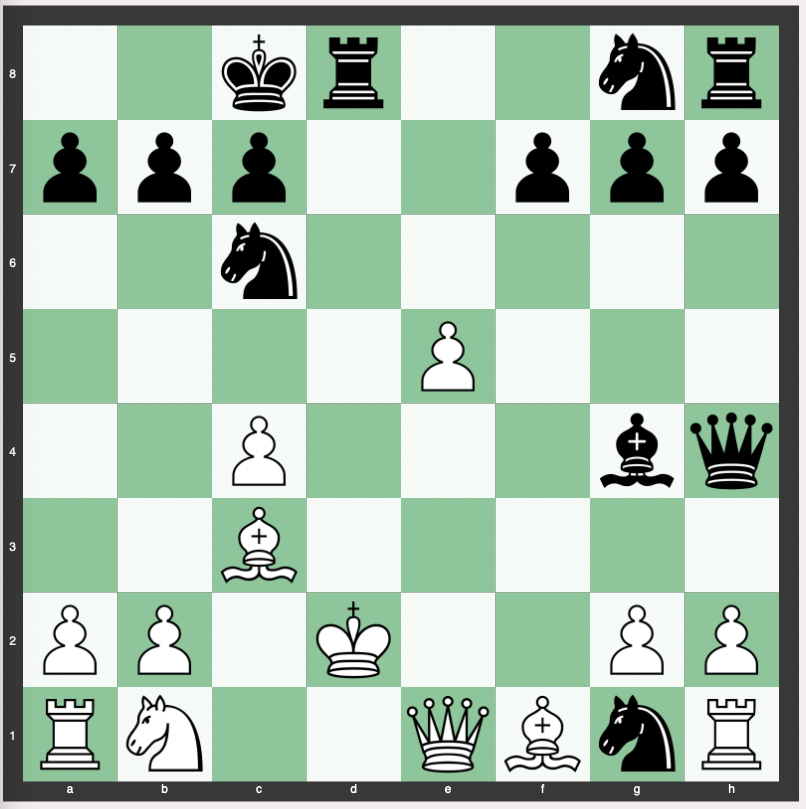The Lasker Trap is a fascinating chess opening trap that occurs in the Albin Countergambit.
Named after Emanuel Lasker, it is intriguing for featuring an underpromotion as early as the seventh move, but was first discovered by Serafino Dubois.
This article aims to shed light on various aspects of the Lasker Trap, including the move order, theory and strategy, variations, history, its suitability for different levels of players, and its frequency in Grandmaster games.
Move Order of the Lasker Trap
The move order of the Lasker Trap (with annotations):
1. d4 d5
2. c4 e5 The Albin Countergambit is initiated.
3. dxe5 d4 The black pawn on d4 is stronger than it appears.
4. e3? Usual and better is 4.Nf3.
4… Bb4+
5. Bd2 dxe3! The trap is being set, with White’s best option being to accept doubled pawns with 6.fxe3.
6. Bxb4?? A critical blunder that falls into the Lasker Trap.
6… exf2+
7. Ke2 fxg1=N+! Promotion to a knight is the key to the trap.
8. Ke1 Qh4+
9. Kd2 9… Nc6 White is lost, with Black having various crushing continuations.
10. Bc3 Bg4 11. Qe1 O-O-O+

Theory, Strategy, and Purpose of Lasker Trap
The Lasker Trap is predicated on a series of tempting mistakes by White, culminating in the unusual underpromotion to a knight.
The black strategy is to lure White into a sequence of suboptimal moves that lead to a surprising and devastating trap.
The trap’s purpose is to provide Black with a rapid and potentially winning advantage by capitalizing on White’s mistakes.
Variations of Lasker Trap
The Lasker Trap has a few variations, including alternate responses from White.
One such line from an 1899 game in Moscow involves 5…dxe3 followed by 6.Qa4+?, leading to a winning position for Black.
The variations underline the need for both sides to understand the intricacies of the opening and the trap.
History of Lasker Trap
Although named after Emanuel Lasker, the Lasker Trap was first noted by Serafino Dubois.
The trap has been known for over a century and has appeared in various games, including the mentioned 1899 consultation game in Moscow.
Is the Lasker Trap Good for Beginners or Intermediates?
The Lasker Trap can be an exciting option for both beginners and intermediate players.
For beginners, it may offer an early victory if White is unaware of the trap.
For intermediate players, understanding the trap adds depth to their understanding of the Albin Countergambit and offers a potentially aggressive option against opponents.
Lasker Trap: Ideas, Strategy, and Tactics to Win in 7 Moves
How Often Is the Lasker Trap Played at the Grandmaster Level?
The Lasker Trap is less common at the Grandmaster level, as players at this level are typically aware of the trap and the pitfalls leading to it.
However, knowledge of the Lasker Trap is vital at all levels, as it forms part of the broader understanding of chess openings and can inform strategy even if the specific trap is not sprung.
Conclusion
The Lasker Trap is a captivating chess opening that weaves together strategy, history, and unusual moves.
While not frequently seen in the highest levels of competitive play, it remains a fascinating study for players at all stages of development.
Its lure lies not only in the unexpected underpromotion but in the broader lessons it teaches about chess strategy, tactics, and the endless depth of this timeless game.


